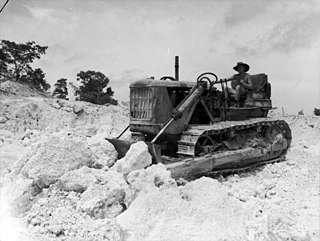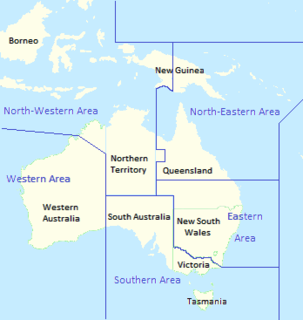The Airfield Defence Guard (ADG) mustering of the Royal Australian Air Force (RAAF) performs specialist ground defence tasks to protect air power assets from hostile ground action. The mustering is composed of non-commissioned members, commonly called 'ADGies,' most of whom are employed within a Security Forces (SECFOR) Squadron (SQN). Their primary role is the protection of RAAF equipment, personnel, assets and facilities during operations. While ADGs train to counter special forces as the primary ground threat to the projection of air power, ADGs are themselves conventional forces. Other duties include training RAAF personnel in weapon handling and basic ground defence tactics.

The Australian First Tactical Air Force was formed on 25 October 1944 by the Royal Australian Air Force (RAAF). Its purpose was to provide a mobile force of fighter and ground attack aircraft that could support Allied army and naval units fighting the Empire of Japan in the South West Pacific Area. One of several Allied tactical air forces formed during World War II, it evolved from the RAAF's No. 10 Operational Group, established a year earlier. Following action in the assaults on Aitape and Noemfoor, the group was renamed the First Tactical Air Force to better reflect its size and role. It was beset with morale and leadership issues in early 1945, but recovered to take part in the battles of Tarakan, North Borneo, and Balikpapan. Reaching its peak strength of over 25,000 personnel in July 1945, No. 1 TAF's squadrons operated such aircraft as the P-40 Kittyhawk, Supermarine Spitfire, Bristol Beaufighter, and B-24 Liberator. The formation remained active following the end of hostilities in the Pacific until it was disbanded on 24 July 1946.

RAAF Base Tindal is a Royal Australian Air Force (RAAF) military air base and civil aviation airfield located 8 nautical miles east southeast of the town of Katherine, Northern Territory in Australia. The base is currently home to No. 75 Squadron and a number of non-flying units, and also hosts the Katherine Tindal Civilian Airport. First constructed in 1942, it was refurbished in the late 1960s as a "bare base" capable of being utilised when required. It was opened as a permanently manned RAAF base in 1989.

No. 4 Squadron is a Royal Australian Air Force squadron composed of the air force special forces Combat Controllers, aircrew who operate the Pilatus PC-9A(F) aircraft and instructors for the Australian Defence Force Joint Terminal Attack Controller (JTAC) course.

No. 452 Squadron is a Royal Australian Air Force (RAAF) air traffic control unit. It was established in 1941 as a fighter squadron, in accordance with Article XV of the Empire Air Training Scheme during World War II. The squadron flew Supermarine Spitfires for the entire war, initially over the United Kingdom and Nazi-occupied Europe. It was later based in Australia and the Netherlands East Indies, before being disbanded in 1945. It was re-raised in its current role in February 2011.

No. 451 Squadron was a Royal Australian Air Force army cooperation and fighter squadron of World War II. It was formed at Bankstown, New South Wales, on 12 February 1941 and began flying operations on 1 July as part of the North African Campaign in Egypt and Libya. No. 451 Squadron was withdrawn for refitting in early January 1942 and spent the remainder of the year performing garrison duties in Syria. In January 1943, it was transferred to Egypt to contribute to local air defence but saw almost no combat. This inactivity caused morale among the squadron's personnel to greatly deteriorate.

No. 20 Squadron is a Royal Australian Air Force (RAAF) support squadron. Coming under the control of No. 96 Wing, it is responsible for the management of the airfield at RAAF Base Woomera, South Australia. The squadron originated as a maritime patrol unit during World War II. Raised in August 1941, it operated PBY Catalina and Short Empire flying boats from bases in New Guinea, Queensland and the Northern Territory, conducting search-and-rescue, mine-laying, anti-submarine and bombing missions against Japanese targets in the Pacific theatre. Following the conclusion of hostilities, the squadron was disbanded in March 1946. It was reactivated as an airfield support squadron in April 2015.

No. 100 Squadron was a Royal Australian Air Force (RAAF) bomber and maritime patrol squadron that operated during World War II. Raised in early 1942 from the remnants of a British unit that had been destroyed in Malaya, the squadron flew Bristol Beauforts from bases in Queensland and New Guinea, undertaking torpedo- and level-bombing sorties against Japanese targets in the Pacific theatre. Following the conclusion of hostilities, the squadron was disbanded in August 1946.

No. 81 Wing is responsible for operating the McDonnell Douglas F/A-18 Hornet multi-role fighters of the Royal Australian Air Force (RAAF). Headquartered at RAAF Base Williamtown, New South Wales, the wing comprises three combat units, Nos. 3 and 77 Squadrons based at Williamtown and No. 75 Squadron at RAAF Base Tindal, Northern Territory, as well as an operational conversion unit at Williamtown. No. 81 Wing headquarters oversees squadron training in air-to-air and air-to-ground tactics, and support for the Australian Army and Royal Australian Navy. Tasked with offensive and defensive counter-air operations, the Hornets have been deployed to Diego Garcia in 2001–02, when they provided local air defence, to Iraq in 2003, when they saw action flying fighter escort and close air support missions in concert with Coalition forces, and to the Middle East in 2015–16, when they undertook strike operations during the military intervention against ISIL. They have also been employed to patrol high-profile events in Australia, including the Commonwealth Games and visits by foreign dignitaries.

No. 462 Squadron is a Royal Australian Air Force (RAAF) squadron which forms part of the Information Warfare Directorate in the RAAF's Air Warfare Centre. The squadron was first formed in 1942 as a heavy bomber unit and saw combat in this role in the Mediterranean area until it was disbanded in March 1944. It was reformed in the United Kingdom in August 1944 to participate in the bombing campaign against Germany, and in December that year converted to a specialist electronic warfare unit. No. 462 Squadron continued in this role until the end of the European war in May 1945 and was disbanded in September that year. The squadron was reformed in its current role during April 2005.

No. 8 Squadron was an Australian flying training squadron of World War I and medium bomber squadron of World War II. The squadron was formed in England in October 1917 as part of the Australian Flying Corps, and disbanded in April 1919. It was re-formed by the Royal Australian Air Force in September 1939. After seeing action during the Pacific War flying Lockheed Hudson and, later, DAF Beaufort bombers, the squadron was disbanded a second time in January 1946.

No. 31 Squadron is a Royal Australian Air Force (RAAF) airbase support squadron. It was formed in August 1942 and disbanded in July 1946 after seeing action against the Japanese in the South West Pacific theatre of World War II. During the war, it operated the Bristol Beaufighter, which it operated in long-range fighter and ground-attack missions. The squadron was re-raised for its current role in July 2010.

Air Marshal Sir John Patrick Joseph McCauley, KBE, CB was a senior commander in the Royal Australian Air Force (RAAF). He served as Chief of the Air Staff from 1954 to 1957. A Duntroon graduate, McCauley spent four years in the Australian Military Forces before transferring to the RAAF in 1924. He was Director of Training from 1936 to 1938, and commanded engineering and flying training schools for the first eighteen months of World War II. Having been promoted to group captain in 1940, he was posted to Singapore in June 1941 to take charge of all RAAF units defending the area. He earned praise for his efforts in attacking invading Japanese forces before the fall of Singapore, and for his dedication in evacuating his men. After serving as Deputy Chief of the Air Staff in 1942–44, he was appointed to a senior operational role with the Royal Air Force's 2nd Tactical Air Force in Europe, where he saw out the rest of the war.

No. 61 Wing was a Royal Australian Air Force (RAAF) airfield construction wing of World War II. The wing was formed in January 1943 and was disbanded in November 1945. During the war, No. 61 Wing and the units under its command served in the North Western Area and South West Pacific Area (SWPA) and played a significant role in supporting RAAF and United States Army Air Forces (USAAF) operations.

No. 5 Airfield Construction Squadron (5ACS) was a Royal Australian Air Force (RAAF) construction squadron. The unit was first formed in July 1942 and served in the New Guinea Campaign and Borneo Campaign during World War II. The squadron was one of only a few RAAF airfield construction units to be retained at the end of the war, and formed part of Australia's contribution to the occupation of Japan from 1945 until it was disbanded in June 1949. 5ACS was re-raised in August 1951 and worked on several RAAF airfields in Australia. In addition, it also provided small detachments of engineers to support RAAF deployments to South Vietnam and Thailand during the Vietnam War. The squadron was the RAAF's only airfield construction unit from 1961 onward, and was disbanded in December 1974.
No. 7 Airfield Construction Squadron (7ACS) was a Royal Australian Air Force (RAAF) construction squadron. The unit was first formed in October 1943 as No. 7 Mobile Works Squadron and served in the New Guinea Campaign and Bougainville Campaign during World War II. 7ACS was disbanded in June 1947.

No. 482 Squadron was a maintenance unit of the Royal Australian Air Force (RAAF). It was formed in May 1942 as No. 4 Repair and Salvage Unit, renamed No. 4 Repair and Servicing Unit in January 1945 and re-formed as No. 482 (Maintenance) Squadron in May 1946. The squadron then became a component of No. 82 (Bomber) Wing at RAAF Station Amberley, Queensland. Over the years it serviced the wing's Consolidated B-24 Liberators, Avro Lincolns, English Electric Canberras, McDonnell Douglas F-4E Phantoms, and General Dynamics F-111Cs. No. 482 Squadron merged with No. 3 Aircraft Depot to form No. 501 Wing in March 1992. No. 501 Wing continued to provide maintenance and logistics support for the F-111Cs at Amberley until disbanding in 2001.

Western Area Command was one of several geographically based commands raised by the Royal Australian Air Force (RAAF) during World War II. It was formed in January 1941, and controlled RAAF units located in Western Australia. Headquartered in Perth, Western Area Command was responsible for air defence, aerial reconnaissance and protection of the sea lanes within its boundaries. Its aircraft conducted anti-submarine operations throughout the war, and attacked targets in the Dutch East Indies during the Borneo campaign in 1945.

North-Western Area Command was one of several geographically based commands raised by the Royal Australian Air Force (RAAF) during World War II. Its wartime sphere of operations included the Northern Territory, adjacent portions of Queensland and Western Australia, and the Dutch East Indies. The command was formed in January 1942, following the outbreak of the Pacific War, from the western part of Northern Area Command, which had covered all of northern Australia and Papua. Headquartered at Darwin, North-Western Area Command was initially responsible for air defence, aerial reconnaissance and protection of the sea lanes within its boundaries.
No. 62 Wing was a Royal Australian Air Force (RAAF) airfield construction wing of World War II. The wing played a significant role in supporting RAAF and United States Army Air Forces (USAAF) operations in the South West Pacific Area (SWPA).




















